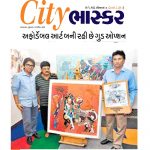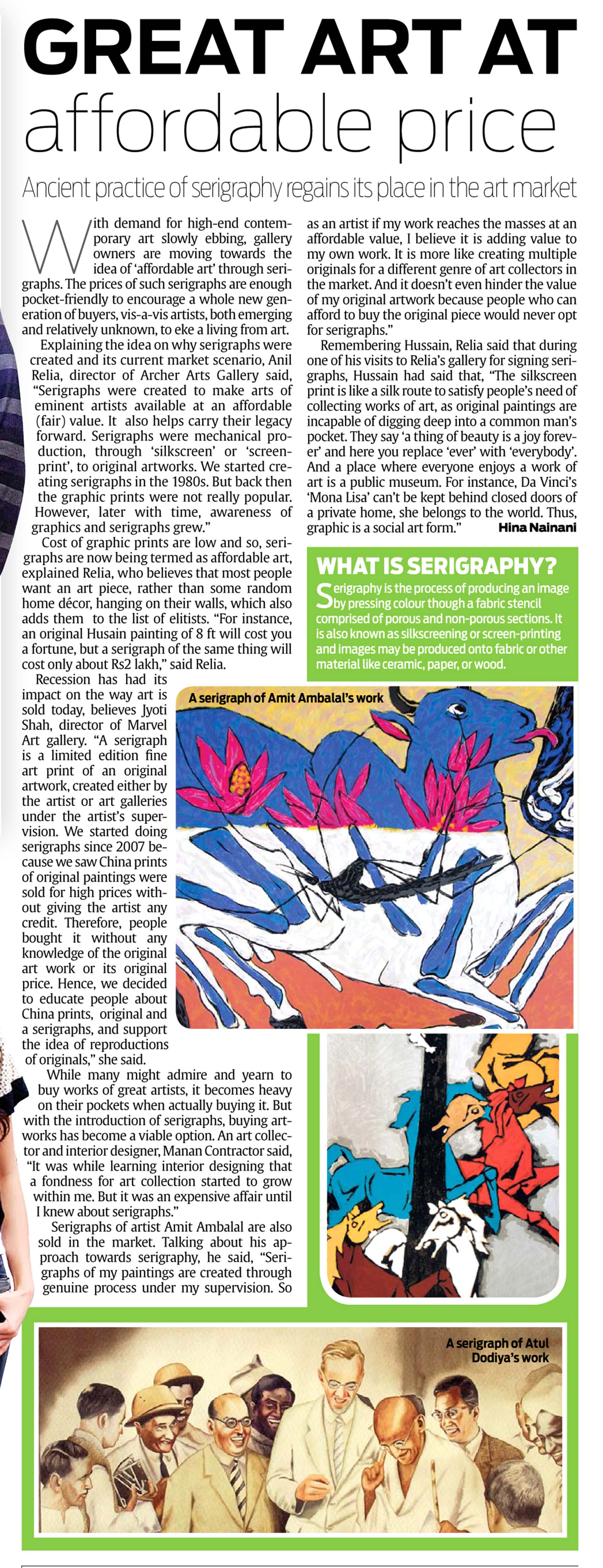Great art at affordable price
Ancient practice of serigraphy regains its place in the art market
With demand for high-end contemporary art slowly ebbing, gallery
owners are moving towards the idea of ‘affordable art’ through
serigraphs. The prices of such serigraphs are enough pocket-friendly
to encourage a whole new generation of buyers, vis-a-vis artists, both
emerging and relatively unknown, to eke a living from art. Explaining the
idea on why serigraphs were created and its current market scenario, Anil
Relia, director of Archer Arts Gallery said,“Serigraphs were created to
make arts of eminent artists available at an affordable (fair) value. It also
helps carry their legacy forward. Serigraphs were mechanical production,
through ‘silkscreen’ or ‘screenprint’, to original artworks. We started creating
serigraphs in the 1980s. But back then the graphic prints were not really popular.
However, later with time, awareness of graphics and serigraphs grew.”
Cost of graphic prints are low and so, serigraphs are now being termed
as affordable art, explained Relia, who believes that most people want an
art piece, rather than some random home décor, hanging on their walls,
which also adds them to the list of elitists. “For instance, an original Husain
painting of 8 ft will cost you a fortune, but a serigraph of the same thing will
cost only about Rs2 lakh,” said Relia.
Recession has had its impact on the way art is sold today, believes Jyoti
Shah, director of Marvel Art gallery. “A serigraph is a limited edition fine
art print of an original artwork, created either by the artist or art galleries
under the artist’s supervision. We started doing serigraphs since 2007
because we saw China prints of original paintings were sold for high prices
without giving the artist any credit. Therefore, people bought it without any
knowledge of the original art work or its original price. Hence, we decided
to educate people about China prints, original and a serigraphs, and support
the idea of reproductions of originals,” she said.
While many might admire and yearn to buy works of great artists, it becomes
heavy on their pockets when actually buying it. But with the introduction of
serigraphs, buying artworks has become a viable option. An art collector
and interior designer, Manan Contractor said, “It was while learning interior
designing that a fondness for art collection started to grow within me. But it
was an expensive affair until I knew about serigraphs.”
Serigraphs of artist Amit Ambalal are also sold in the market. Talking about his
approach towards serigraphy, he said, “Serigraphs of my paintings are created
through genuine process under my supervision. So as an artist if my work reaches
the masses at an affordable value, I believe it is adding value to my own work.
It is more like creating multiple originals for a different genre of art collectors in
the market. And it doesn’t even hinder the value of my original artwork because
people who can afford to buy the original piece would never opt for serigraphs.”
Remembering Hussain, Relia said that during one of his visits to Relia’s gallery
for signing serigraphs, Hussain had said that, “The silkscreen print is like a silk
route to satisfy people’s need of collecting works of art, as original paintings are
incapable of digging deep into a common man’s pocket. They say ‘a thing of
beauty is a joy forever’ and here you replace ‘ever’ with ‘everybody’. And a place
where everyone enjoys a work of art is a public museum. For instance, Da Vinci’s
‘Mona Lisa’ can’t be kept behind closed doors of a private home, she belongs to
the world. Thus, graphic is a social art form.”
What is serigraphy?
Serigraphy is the process of producing an image
by pressing colour though a fabric stencil
comprised of porous and non-porous sections. It
is also known as silkscreening or screen-printing
and images may be produced onto fabric or other
material like ceramic, paper, or wood.
-Hina Nainani








